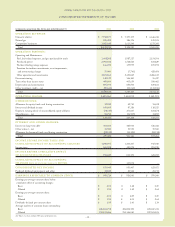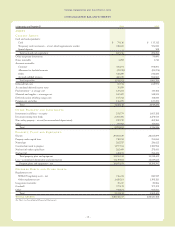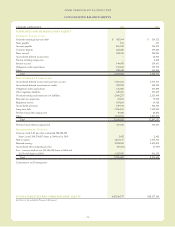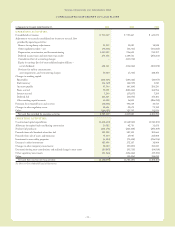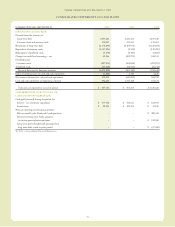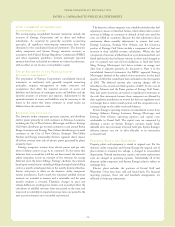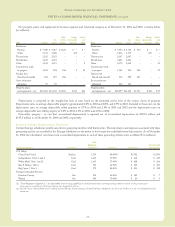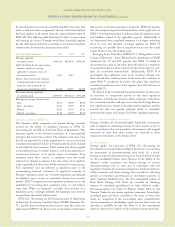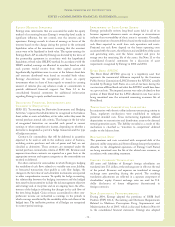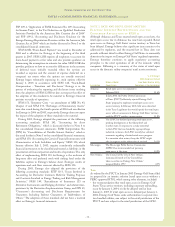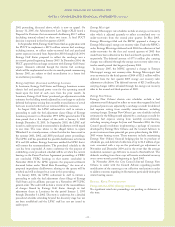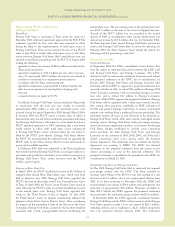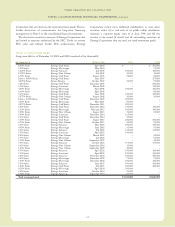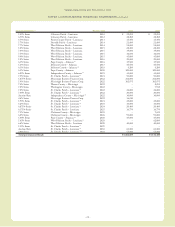Entergy 2004 Annual Report Download - page 60
Download and view the complete annual report
Please find page 60 of the 2004 Entergy annual report below. You can navigate through the pages in the report by either clicking on the pages listed below, or by using the keyword search tool below to find specific information within the annual report.
-58 -
Entergy Corporation and Subsidiaries 2004
Equity Method Investees
Entergy owns investments that are accounted for under the equity
method of accounting because Entergy’s ownership level results in
significant influence, but not control, over the investee and its
operations. Entergy records its share of earnings or losses of the
investee based on the change during the period in the estimated
liquidation value of the investment, assuming that the investee’s
assets were to be liquidated at book value. The equity earnings for
Entergy-Koch, LP recorded by Entergy are dictated by the terms of
the partnership agreement in accordance with the hypothetical
liquidation at book value (HLBV) method. In accordance with the
HLBV method, earnings are allocated to members based on what
each partner would receive from their capital account if,
hypothetically, liquidation were to occur at the balance sheet date
and amounts distributed were based on recorded book values.
Entergy discontinues the recognition of losses on equity
investments when its share of losses equals or exceeds its carrying
amount of investee plus any advances made or commitments to
provide additional financial support. See Note 12 to the
consolidated financial statements for additional information
regarding Entergy’s equity method investments.
Derivative Financial Instruments and
Commodity Derivatives
SFAS 133, “Accounting for Derivative Instruments and Hedging
Activities,” requires that all derivatives be recognized in the balance
sheet, either as assets or liabilities, at fair value, unless theymeet the
normal purchase, normal sales criteria. The changes in the fair value
of recognized derivatives are recorded each period in current
earnings or other comprehensiveincome, depending on whether a
derivativeis designated as partof a hedge transaction and the type
of hedge transaction.
Contracts for commodities that will be delivered in quantities
expected to be used or sold in the ordinarycourse of business,
including certain purchases and sales of power and fuel, are not
classified as derivatives. These contracts are exempted under the
normal purchase, normal sales criteria of SFAS 133. Revenues and
expenses fromthese contracts are reported on a gross basis in the
appropriate revenue and expense categories as the commodities are
received or delivered.
For other contracts for commodities in which Entergy is hedging
the variability of cash flows related to a variable-rate asset, liability,
or forecasted transactions that qualify as cash flow hedges, the
changes in the fair value of suchderivativeinstruments are reported
in other comprehensive income. To qualify for hedge accounting,
the relationship between the hedging instrument and the hedged
item must be documented to include the risk management objective
and strategyand, at inception and on an ongoing basis, the effec-
tiveness of the hedge in offsetting the changes in the cash flows of
the item being hedged. Gains or losses accumulated in other com-
prehensiveincome are reclassified as earnings in the periods in
which earnings are affected by the variability of the cash flows of the
hedged item. The ineffectiveportions of all hedges are recognized
in current-period earnings.
Impairment of Long-Lived Assets
Entergy periodically reviews long-lived assets held in all of its
business segments whenever events or changes in circumstances
indicate that recoverability of these assets is uncertain. Generally,
the determination of recoverability is based on the undiscounted net
cash flows expected to result from such operations and assets.
Projected net cash flows depend on the future operating costs
associated with the assets, the efficiency and availability of the assets
and generating units, and the future market and price for
energy over the remaining life of the assets. See Note 11 to the
consolidated financial statements for a discussion of asset
impairments recognized by Entergy in 2002 and 2004.
River Bend AFUDC
The River Bend AFUDC gross-up is a regulatory asset that
represents the incremental difference imputed by the Louisiana
Public Service Commission (LPSC) between the AFUDC actually
recorded by Entergy Gulf States on a net-of-tax basis during the
construction of River Bend and what the AFUDC would have been
on a pre-tax basis.The imputed amount was only calculated on that
portion of River Bend that the LPSC allowed in rate base and is
being amortized over the estimated remaining economic life of
River Bend.
Transitionto CompetitionLiabilities
In conjunction with electric utility industry restructuring activity in
Texas, regulatory mechanisms were established to mitigate
potential stranded costs. Texas restructuring legislation allowed
depreciation on transmission and distribution assets to be directed
toward generation assets. The liability recorded as a result of this
mechanism is classified as “transitionto competition” deferred
credits on the balance sheet.
Reacquired Debt
The premiums and costs associated with reacquired debt of the
domestic utilitycompanies and System Energy (except that portion
allocable to the deregulated operations of Entergy Gulf States)
arebeing amortized over the life of the related new issuances, in
accordance with ratemaking treatment.
Foreign Currency Translation
All assets and liabilities of Entergy’s foreign subsidiaries are
translated into U.S. dollars at the exchange rate in effect at the end
of the period. Revenues and expenses are translated at average
exchange rates prevailing during the period. The resulting
translation adjustments are reflected in a separate component of
shareholders’ equity. Current exchange rates are used for U.S.
dollar disclosures of future obligations denominated in
foreign currencies.
New Accounting Pronouncements
During 2004, Entergy adopted the provisions of FASB Staff
Position(FSP) 106-2, “Accounting and Disclosure Requirements
Related to Medicare Prescription Drug, Improvement and
Modernization Act of 2003,” which is discussed further in Note 10
to the consolidated financial statements. Entergy also adopted
NOTES to CONSOLIDATED FINANCIAL STATEMENTS continued


